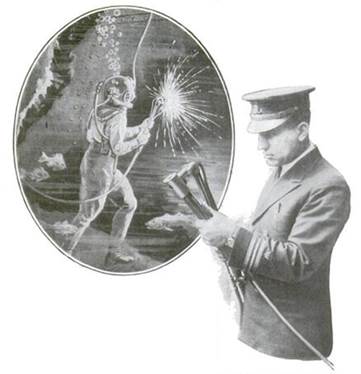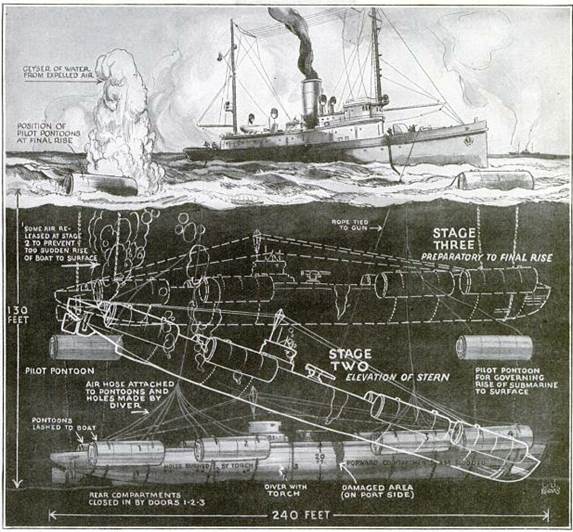[Part 1 was published earlier this week on Commander Ellsberg’s birthday. Read more after the break.]
In 1925, Ellsberg was still living in the shipyard. He had the job of dismantling two nearly completed 45000 ton battleships – under the terms of the Geneva Conference, the United States had agreed to scrap construction of ships for the next 10 years.
“I always awakened at a certain time to have breakfast, to dress and to go to work. But one morning I awakened at 5 a.m., couldn’t get back to sleep and went out to walk for a while. It had never happened before. I stood on a dock and watched a Navy diving ship, the Falcon, hurriedly loading equipment on board. There was a frantic urgency about the activities. The captain appeared on deck and I called to him. A submarine — the S-51 — had sunk off Block Island. No one aboard the Falcon was knowledgeable.”
He got aboard the Falcon and went out with the rescuers. They stayed out three days. The crew had died, but the Navy wanted to recover the submarine. When he went back, he proposed that he could raise the ship. The Navy was about to sign a contract to get commercial divers to salvage the submarine, but the commander of the Brooklyn Ship Yard convinced them that the Navy could do the job on its own.
No salvage of this nature, from a depth of twenty two fathoms (one hundred and thirty two feet) had been attempted before. No tool existed to cut steel and iron; existing welding torches would not work under water. No problem. Ellsberg invented, and patented, a welding torch for the job. It worked by supplying air under pressure to the torch in such a manner that it formed an envelope around the flame.
 |
| Lt. Commander Edward Ellsberg with his invention – the underwater welding torch c. 1926 (Source: Popular Science, June, 1926) |
The submarine had sunk in a bed of sticky clay. This meant that the lifting force that had to be applied was much more than that required to make the submarine float. Ellsberg had a plan. Divers wired pontoons to the wreck. These pontoons could be filled with air by a hose from the surface. Once the pontoons were attached, they planned to pump air into the hull. With the added buoyancy from the pontoons, they could raise the sunken submarine. They hoped.
 |
| The plan to raise the sunken submarine, S-51 (Source: Popular Science, June, 1926) |
No one knew if it would work. Nine months after they started, and many dives later, they brought the S-51 to the surface. Ellsberg did not know diving at the beginning of the operation. By the end, he was an experienced diver. He had started going down with his team of divers and working with them to understand the problems they faced.
When he got back, his squadron commander, Capt. Joseph Edward King, recommended him for a Naval Distinguished Service Medal and promotion to the rank of Commander. Ellsberg’s first book, On the Bottom, about the raising of the S-51, was published in 1928.
Ellsberg’s technical background (he had left the line officer corps to go into naval construction), rather than ship command weighed against him in the US navy of the time. Frustrated with the naval bureaucracy and the slow pace of his career, he left the navy in 1925 and went to work as chief engineer for the Tidewater Oil Company. Part of the reason behind the change was also the higher salary in the private sector, which recognized his merit.
In 1927, the submarine S-4 sank. The majority of the crew perished instantly, but six men were trapped alive. Although Ellsberg was no longer in the navy, he volunteered to work for the rescue, which failed. He also took part in the initial two weeks of the subsequent salvage effort. Twice during this effort, he nearly died. The first time he dived, a faulty valve in his helmet cut off part of his air supply. When he surfaced, he fell on the Falcon’s deck in agony, suffering from the bends. He dived again after recovering from this.
While inspecting the submarine, he was surrounded by a cloud of mud. He lost all sense of direction. He knew he was still standing on the hull of the sunken submarine, but he couldn’t see the submarine itself. One step in the wrong direction might mean death. This is the story he told:
“I stopped instantly, I was afraid that if I took a single step the wrong way. I would go sliding overboard from the round hull on which I stood. I was completely lost. I stood in there motionless, afraid to move. Then the Falcon, the ship to which my lifeline was fastened on the surface of the sea, took a sudden lunge on a wave and my lifeline tightened. I was thrown off balance and down I went, over the side of the sunken submarine.
I was terrified because I had cut open my watertight glove and was rapidly losing air. As the air went out the sea began pressing in on my chest. I could hardly breathe, I knew my chest would soon be crushed. I hit bottom, but instead of stopping, I shot down farther into the soft mud.
I was in total darkness and I was lying on the twisted wreckage which had been torn from the keel of the ship that sunk the submarine. I feared that if I moved, those jagged steel plates would cut my suit wide open, and that would mean almost instant death.
Finally, in desperation, I signaled my helper on the surface to pull up my lifeline. Four men heaved on the lines, but I couldn’t feel the slightest pull. My lines were fouled in the wreckage above l me. I could feel the pressure of the Atlantic numbing my brain. I kept thinking of the 40 dead men inside the sunken submarine and I knew I would soon join them in death.
Then gradually I became aware of a persistent murmur. I was still getting some air through my air hose. I opened wide the air inlet valve and suddenly the air started to inflate my suit. Then, as if a giant hand had seized me by the shoulders, my body started to float upward through the mud. Another moment and I was free of that bed of sharp, torn steel plates. Then my helmet burst through the ooze of the ocean floor into the water and into the light. I looked up. My lifeline and air hose were floating straight above me. I was clear at last. I was saved.”
|
Between 1927 and 1933, Ellsberg filed at least four more patents. This was also the time when he wrote stories that appeared in the Saturday Evening Post and Adventure. He also published two novels, Thirty Fathoms Deep and Pigboats, and a collection of short stories titled S-54. Pigboats had been serialized in Adventure earlier, and was later made into the movie Hell Below, starring Robert Montgomery, Robert Young, Jimmy Durante and Madge Evans. S-54 collected the stories that had been printed in magazines. His last story in Adventure appeared in 1941.
In 1935, after working with the Tidewater Oil Company for nine years, he quit to devote more time to writing and work as a consulting engineer. Hitler had become Chancellor of Germany. Ellsberg saw war in the future, and went on a commercial lecture tour to warn the American people of the coming danger and the need for preparedness. He travelled around the country from 1936 to 1940, lecturing on the coming war.
On July 7, 1941, Ellsberg was listening to a concert broadcast on the radio. The program was interrupted with a one-line announcement: “The Japanese are bombing Pearl Harbor.” He got on the night train to Washington, and saw Admiral Nimitz. Within an hour, Ellsberg had rejoined the navy. Because of his writing experience, they wanted him to take a public relations job.
Before he could decide what to do, his former superior, Capt. Joseph King, now an Admiral, was made Chief of Naval Operations, and came to Washington. King called Ellsberg in and told him that Britain needed a salvage man in North Africa and the Red Sea. The only salvage officer the US had was needed in Pearl Harbor. So Ellsberg went to Massowa Harbor in Eritrea.
Part 3
Part 3
To be continued…




I have the original oil painting used for the cover of Ellsberg's Submarine Gold, pictured above.
Excellent! Care to share a photo?